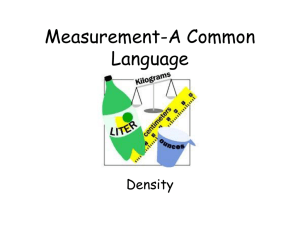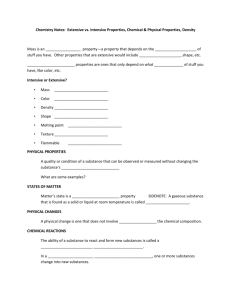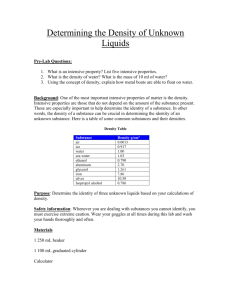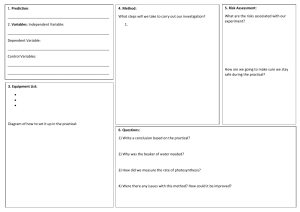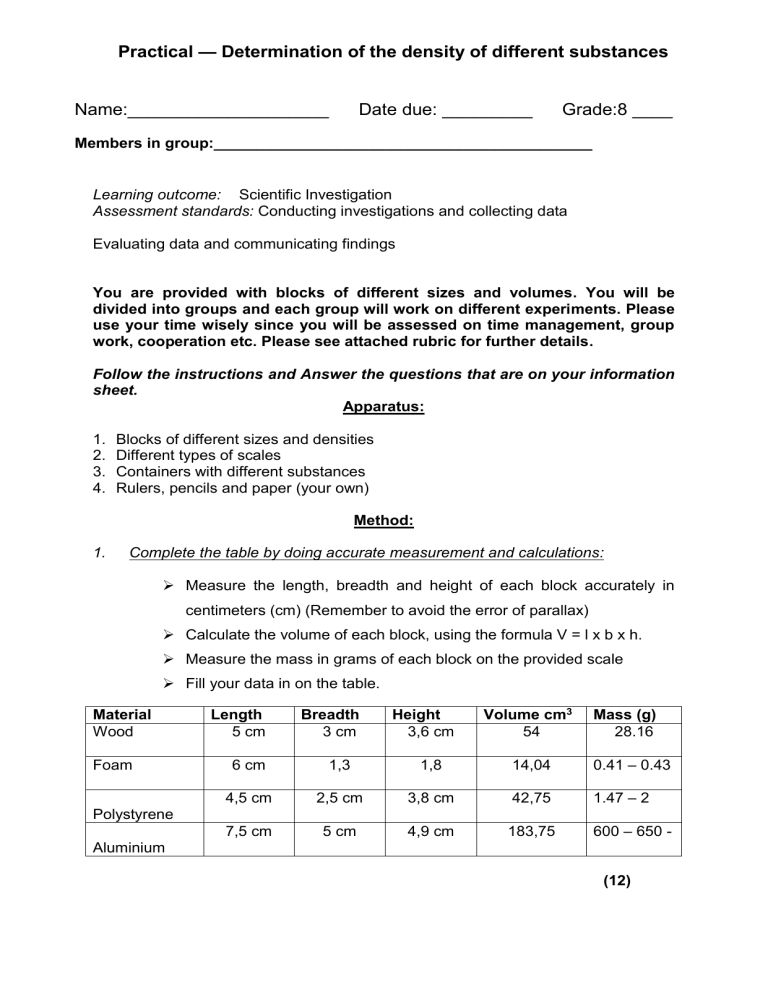
Practical — Determination of the density of different substances Name:____________________ Date due: _________ Grade:8 ____ Members in group:____________________________________________ Learning outcome: Scientific Investigation Assessment standards: Conducting investigations and collecting data Evaluating data and communicating findings You are provided with blocks of different sizes and volumes. You will be divided into groups and each group will work on different experiments. Please use your time wisely since you will be assessed on time management, group work, cooperation etc. Please see attached rubric for further details. Follow the instructions and Answer the questions that are on your information sheet. Apparatus: 1. 2. 3. 4. Blocks of different sizes and densities Different types of scales Containers with different substances Rulers, pencils and paper (your own) Method: 1. Complete the table by doing accurate measurement and calculations: Measure the length, breadth and height of each block accurately in centimeters (cm) (Remember to avoid the error of parallax) Calculate the volume of each block, using the formula V = l x b x h. Measure the mass in grams of each block on the provided scale Fill your data in on the table. Material Wood Foam Length 5 cm Breadth 3 cm Height 3,6 cm Volume cm3 54 Mass (g) 28.16 6 cm 1,3 1,8 14,04 0.41 – 0.43 4,5 cm 2,5 cm 3,8 cm 42,75 1.47 – 2 7,5 cm 5 cm 4,9 cm 183,75 600 – 650 - Polystyrene Aluminium (12) 2. Containers with different substances Pick up each cup up and compare how heavy each one is. Sort the materials in the cups from least to most dense. Most Dense Lentils Least Dense Foam balls Beans Sand (4) 3. Compare densities of liquids Pour some water into a beaker. Add 1 or 2 drops of food coloring to the water to make it easier to see Pour a small amount of oil slowly into the beaker – allow the oil to run slowly down the inside of the beaker. Experimental Technique: Messy (1) Satisfactory (2) Good (3) Excellent (4) (4) Answer the following questions on a separate piece of paper: Experiment 1: Calculate the densities for each of the blocks. (12) Experiment 2 Draw a conclusion to the results you got. (2) Explain how this investigation was a fair test. Which variables were kept the same? Which variable was changed (3) Experiment 3 Use the particle model of matter to explain your results. Criteria 0 1 (2) 2 3 TOTAL Organisation Use of time Participation in group Neatness Dogs breakfast Nearly illegible Sloppy Neat 12 50 Late handing in will cost you 5 marks per day. If you lose your practical notes, this will cost you 10 marks EXPERIMENT 1 ANSWERS Wood: D= = 0.51-0.52 (4) Foam: D= = 0.029 – 0.032 (4) Polystyrene: D = = 0.034 – 0,047 (4) Iron: = 3,26 (4) D= EXPERIMENT 2 ANSWERS Since the volume was kept the same the mass influenced the density. The heavier the container was the more its density. The closer the particles are to each other the denser the object will be (2) EXPERIMENT 3 ANSWERS Oil is more dense than water i.e. the particles of oil is closer to each other than the particles in water therefore the oil will float on the water (2) This was a fair test because the volume of the substances and the containers were kept the same. The only thing that was changed was the substance itself.
